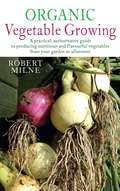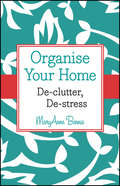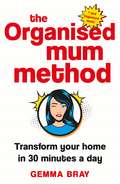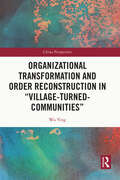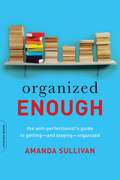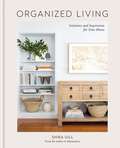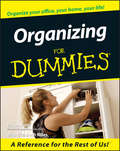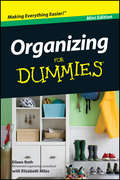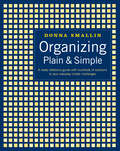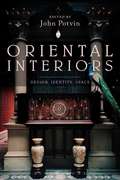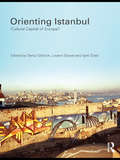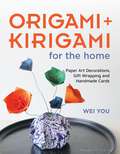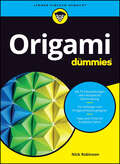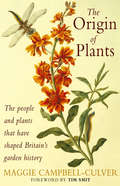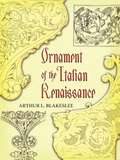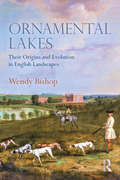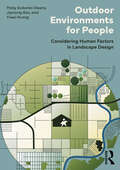- Table View
- List View
Organic Vegetable Growing: The Complete Guide to Growing Nutritious and Tasty Vegetables the Organic Way
by Robert MilneGrowing your own organic vegetables will give you fresher, tastier and more nutritious produce with no food miles, fossil fuel use or packaging; and will provide you with the simple but enormous pleasure and satisfaction of supplying at least part of your own food requirements. This authoritative book provides detailed, practical guidance for those who wish to make the most of their time and whatever area of ground is available to grow vegetables the organic way. It looks forward to productive gardening becoming increasingly relevant and necessary as we are obliged to adapt to global trends, including climate change and diminishing oil resources that will adversely affect food production. The techniques described are applicable to any scale of gardening and are based on the author's thirty years of organic gardening experience, including twenty years of self-sufficiency and eight as a professional gardener growing vegetables and fruit in walled gardens.
Organise Your Home: De-clutter, De-stress
by MaryAnne BennieIs your clutter taking control of your life? Organise Your Home will show you how to use the in8steps system and organise your entire home without turning it into total chaos in the process. Work at a pace your lifestyle allows and use this tried-and-tested system to completely overhaul your relationship with your stuff. MaryAnne Bennie is an organising expert, speaker and director of in8 home office and life organising.
Organise Your Home: De-clutter, De-stress
by MaryAnne BennieIs your clutter taking control of your life? Organise Your Home will show you how to use the in8steps system and organise your entire home without turning it into total chaos in the process. Work at a pace your lifestyle allows and use this tried-and-tested system to completely overhaul your relationship with your stuff. MaryAnne Bennie is an organising expert, speaker and director of in8 home office and life organising.
The Organised Mum Method: Transform your home in 30 minutes a day
by Gemma BrayThe Organised Mum Method is THE housekeeping bible that will completely revolutionise your home.Say goodbye to mess, clutter and weekends spent tidying and cleaning! Gemma Bray (a.k.a The Organised Mum) is a firm believer that there is more to life than housework, and over the last decade she has perfected The Organised Mum Method (TOMM).* The Organised Mum Method is a structured, manageable and ultra-efficient cleaning routine that ensures all areas of the home are taken care of. It's easy to follow, effective and ensures that everything gets done in just 30 minutes a day, Monday to Friday ... and you get weekends off!Perfect for existing fans of TOMM or anyone looking for ways to fit cleaning around a busy lifestyle, The Organised Mum Method includes life-changing tips, tricks, cleaning schedules, shopping lists, meal plans and quick recipes that will help you get your housework done fast.*Don't worry dads -- it works for you too.
Organizational Transformation and Order Reconstruction in "Village-Turned-Communities" (China Perspectives)
by WU YingSince the beginning of the 21st century, a state-led urbanization has evolved into a "city management" in China: a large number of villages were demolished; cultivated land was centralized; and peasants went to live in apartments, which led to the widespread emergence of "village-turned-communities". This title explores the evolving and complex relationship between the urbanization of land and people – two core components of China’s urbanization strategy. What role does the government play in creating conflicts around these two aspects of urbanization? What role can it play in adjudicating them? To answer these questions, the author examines rural migrants’ experience in integrating and being integrated into the cities. Through a three-year investigation in Beijing, Shandong, Wuhan and Yunnan, the author shows how government policies can either engender or mitigate conflicts, as well as identifies integrated governance as an effective approach to urbanization of both land and people. This title is awarded the top ten Chinese sociology books in 2019. Students and scholars of sociology, politics and public administration will benefit from this book.
Organizational Transformation and Order Reconstruction in "Village-Turned-Communities" (China Perspectives)
by WU YingSince the beginning of the 21st century, a state-led urbanization has evolved into a "city management" in China: a large number of villages were demolished; cultivated land was centralized; and peasants went to live in apartments, which led to the widespread emergence of "village-turned-communities". This title explores the evolving and complex relationship between the urbanization of land and people – two core components of China’s urbanization strategy. What role does the government play in creating conflicts around these two aspects of urbanization? What role can it play in adjudicating them? To answer these questions, the author examines rural migrants’ experience in integrating and being integrated into the cities. Through a three-year investigation in Beijing, Shandong, Wuhan and Yunnan, the author shows how government policies can either engender or mitigate conflicts, as well as identifies integrated governance as an effective approach to urbanization of both land and people. This title is awarded the top ten Chinese sociology books in 2019. Students and scholars of sociology, politics and public administration will benefit from this book.
Organized Enough: The Anti-Perfectionist's Guide to Getting--and Staying--Organized
by Amanda SullivanIf you're looking to clean up but not clean out, if you want to declutter but don't want to throw out eighty percent of your stuff, if you want to be able to find matching socks in the morning but don't want a color-coded sock drawer, you've come to the right place. Organized Enough offers a groundbreaking, science-driven method for getting--and staying--organized. Amanda Sullivan's proven approach will teach you the lifelong habits of the organized, showing you how to make cleaning up effortless and automatic. With seven concepts to help you define your goals and seven essential habits to keep chaos and clutter at bay, Organized Enough will teach you to reframe how you think about your space, your stuff, and your life. You'll learn how to:Sort the "stuff" from the sentimentalBecome a paper-filing ninjaCultivate consistency, not chaosSet up systems that can run on autopilotLet go of guilt and start enjoying your home...and more
Organized Enough: The Anti-Perfectionist's Guide to Getting -- and Staying -- Organized
by Amanda SullivanIf you're looking to clean up but not clean out, if you want to declutter but don't want to throw out eighty percent of your stuff, if you want to be able to find matching socks in the morning but don't want a color-coded sock drawer, you've come to the right place. Organized Enough offers a groundbreaking, science-driven method for getting -- and staying -- organized. Amanda Sullivan's proven approach will teach you the lifelong habits of the organized, showing you how to make cleaning up effortless and automatic. With seven concepts to help you define your goals and seven essential habits to keep chaos and clutter at bay, Organized Enough will teach you to reframe how you think about your space, your stuff, and your life. You'll learn how to:Sort the "stuff" from the sentimentalBecome a paper-filing ninjaCultivate consistency, not chaosSet up systems that can run on autopilotLet go of guilt and start enjoying your home...and more
Organized Living: Solutions and Inspiration for Your Home
by Shira GillGet inspired to level up your home organization with tips, Q&As, and photos of the living spaces of twenty-five international home organizers, from the author of Minimalista. Whenever people learn that Shira Gill is a professional home organizer, they always lean in and ask the same question: "So, is your home really that organized?" Spoiler alert: the answer is yes. Organized Living was inspired by Shira's desire to give others a glimpse into this rarely-seen world: The ultra-organized homes of people who organize others. There are plenty of books highlighting the spaces and stories of designers, entrepreneurs, and creatives; here, Shira showcases the homes of home organizers, from London to Lisbon, Paris to Portland, giving you an exclusive behind-the-scenes look into this meticulously kept world. Organized Living will introduce you to not only the aspirational spaces of the most organized people in the world, but also to the organizers themselves and the passion that fuels their work. Through images and interviews, you'll gain expert tips and resources, loads of visual inspiration, and clever organizing hacks you can use in your own home, such as: - Ditching the packaging - Choosing stylish storage- Elevating the most neglected spaces - Putting things away, right away People are naturally curious about the homes of professional organizers. With books, TV shows, and the arrival of viral and global celebrity organizer, Marie Kondo, home organizers have been elevated as top lifestyle influencers. Through blogs, podcasts, and social media platforms like Instagram, home organizers have further cemented their place in the cultural zeitgeist. And Shira Gill, the organizer of organizers, is the perfect tour guide to walk us through these professional organizers' homes featured in her latest book.
Organizing For Dummies (For Dummies Ser.)
by Eileen Roth Elizabeth MilesWhat’s the favorite four-letter word of people who are less than fully organized? “Help!” So many technological, social, and economic changes affect your life that you need organization just to keep up, let alone advance. Many people have two jobs – one at the office and one taking care of things at home. If you have a family, you may count that as a third job. Caring for elderly relatives or have community commitments? You can count off four, five, and keep right on going. No matter what life stage you’re in, getting organized can make every day better and help you achieve your long-term goals. Organizing For Dummies is for anyone who wants to Polish his or her professional reputation Experience less stress Increase productivity Build better relationships Maximize personal time Organization isn’t inherited. With the human genome decoded, the evidence is clear: DNA strings dedicated to putting things into place and managing your time like a pro are nonexistent. Instead, organization is a learned skill set. Organizing For Dummies helps you gain that skill with topics such as: Understanding how clutter costs you in time, money, and health Training your mind to be organized and developing a plan Cleaning house, room by room, from basement to attic (including the garage) Creating functional space for efficiency and storage Time-management strategies for home, office, and tavel Scheduling, delegating, and multitasking Making time for your family Managing your health – physical and financial Finding time for love Organizing and cashing in on a great garage sale Getting organized is about unstuffing your life, clearing out the dead weight in places from your closet to your calendar to your computer, and then installing systems that keep the good stuff in its place. Organizing is a liberating and enlightening experience that can enhance your effectiveness and lessen your stress every day – and it’s all yours simply for saying “No” to clutter.
Organizing Plain & Simple: A Ready Reference Guide with Hundreds of Solutions to Your Everyday Clutter Challenges
by Donna SmallinTake control of everyday disorder. With strategies for everything from keeping track of mittens and scarves to combining two households, Donna Smallin takes a personalized, nonjudgmental approach as she explains how to assess different situations and decide where to start organizing. Whether you&’re craving a more functional closet, having trouble planning meals for your family, or trying to make sense of your finances, this straightforward guide offers proven techniques for living an efficient and clutter-free life. This publication conforms to the EPUB Accessibility specification at WCAG 2.0 Level AA.
Oriental Interiors: Design, Identity, Space
by Edited by John PotvinSince the publication of Edward Said's groundbreaking work Orientalism 35 years ago, numerous studies have explored the West's fraught and enduring fascination with the so-called Orient. Focusing their critical attention on the literary and pictorial arts, these studies have, to date, largely neglected the world of interior design. Oriental Interiors is the first book to fully explore the formation and perception of eastern-inspired interiors from an orientalist perspective. Orientalist spaces in the West have taken numerous forms since the 18th century to the present day, and the fifteen chapters in this collection reflect that diversity, dealing with subjects as varied and engaging as harems, Turkish baths on RMS Titanic, Parisian bachelor quarters, potted palms, and contemporary yoga studios. It explores how furnishings, surface treatments, ornament and music, for example, are deployed to enhance the exoticism and pleasures of oriental spaces, looking across a range of international locations. Organized into three parts, each introduced by the editor, the essays are grouped by theme to highlight critical paths into the intersections between orientalist studies, spatial theory, design studies, visual culture and gender studies, making this essential reading for students and researchers alike.
Oriental Interiors: Design, Identity, Space
by John PotvinSince the publication of Edward Said's groundbreaking work Orientalism 35 years ago, numerous studies have explored the West's fraught and enduring fascination with the so-called Orient. Focusing their critical attention on the literary and pictorial arts, these studies have, to date, largely neglected the world of interior design. Oriental Interiors is the first book to fully explore the formation and perception of eastern-inspired interiors from an orientalist perspective. Orientalist spaces in the West have taken numerous forms since the 18th century to the present day, and the fifteen chapters in this collection reflect that diversity, dealing with subjects as varied and engaging as harems, Turkish baths on RMS Titanic, Parisian bachelor quarters, potted palms, and contemporary yoga studios. It explores how furnishings, surface treatments, ornament and music, for example, are deployed to enhance the exoticism and pleasures of oriental spaces, looking across a range of international locations. Organized into three parts, each introduced by the editor, the essays are grouped by theme to highlight critical paths into the intersections between orientalist studies, spatial theory, design studies, visual culture and gender studies, making this essential reading for students and researchers alike.
Orienting Istanbul: Cultural Capital of Europe? (Planning, History and Environment Series)
by Deniz GöktürkLooking at the globalization, urban regeneration, arts events and cultural spectacles, this book considers a city not until now included in the global city debate. Divided into five parts, each preceded by an editorial introduction, this book is an interdisciplinary study of an iconic city, a city facing conflicting social, political and cultural pressures in its search for a place in Europe and on the world stage in the twenty-first century.
Orienting Istanbul: Cultural Capital of Europe? (Planning, History and Environment Series)
by Deniz Göktürk Levent Soysal Ipek TureliLooking at the globalization, urban regeneration, arts events and cultural spectacles, this book considers a city not until now included in the global city debate. Divided into five parts, each preceded by an editorial introduction, this book is an interdisciplinary study of an iconic city, a city facing conflicting social, political and cultural pressures in its search for a place in Europe and on the world stage in the twenty-first century.
Origami and Kirigami for the Home: Paper Art Decorations, Gift Wrapping and Handmade Cards
by Wei YouA colourful guide (with accompanying online video tutorials) to creating decorative pieces for the home, parties and events alongside ideas for presents, cards and gift wrapping.Origami is the Japanese art of paper folding and kirigami is the traditional art of paper cutting. In this beautifully illustrated book, paper artist Wei You introduces you to over 30 unique projects for your home that can be made by anyone, regardless of experience. After learning the basic folds, discover different paper types – try out pretty handmade ones such as mulberry and decorative washi, or experiment with the full rainbow of classic origami paper – and find a wealth of ideas from table decorations and tiles, to gift wrap and seasonal decorations. In no time at all you will have the skills to craft delicate roses and stylish card holders, striking wall art to decorate your home, parties and events, as well as unique eco-friendly ideas for presents and cards. Easy-to-follow instructions, photographs and diagrams guide you step by step through traditional and contemporary designs and accompanying videos for each origami project will ensure you develop your skills to create some truly impressive makes. Paper is more than just a blank page to write on – grab yourself a bundle and get started folding, cutting and creating your own paper magic!
Origami and Kirigami for the Home: Paper Art Decorations, Gift Wrapping and Handmade Cards
by Wei YouA colourful guide (with accompanying online video tutorials) to creating decorative pieces for the home, parties and events alongside ideas for presents, cards and gift wrapping.Origami is the Japanese art of paper folding and kirigami is the traditional art of paper cutting. In this beautifully illustrated book, paper artist Wei You introduces you to over 30 unique projects for your home that can be made by anyone, regardless of experience. After learning the basic folds, discover different paper types – try out pretty handmade ones such as mulberry and decorative washi, or experiment with the full rainbow of classic origami paper – and find a wealth of ideas from table decorations and tiles, to gift wrap and seasonal decorations. In no time at all you will have the skills to craft delicate roses and stylish card holders, striking wall art to decorate your home, parties and events, as well as unique eco-friendly ideas for presents and cards. Easy-to-follow instructions, photographs and diagrams guide you step by step through traditional and contemporary designs and accompanying videos for each origami project will ensure you develop your skills to create some truly impressive makes. Paper is more than just a blank page to write on – grab yourself a bundle and get started folding, cutting and creating your own paper magic!
Origami für Dummies (Für Dummies)
by Nick RobinsonMehr als nur Papiertiger Wollten Sie schon immer die uralte Kunst des Origami meistern? Dann ist dieses Buch genau das Richtige für Sie. Verständliche Schritt-für-Schritt-Anleitungen, bestehend aus Abbildungen und begleitendem Text, helfen Ihnen dabei, ein langweiliges Stück Papier in die verschiedensten Origami-Modelle zu verwandeln. Egal ob Anfänger oder Fortgeschrittener - für jeden ist das richtige dabei. Dabei gibt der Autor auch allgemeine Tipps zur perfekten Faltung, zum Erstellen eigener Modelle und verrät, was zu tun ist, wenn Sie mal nicht weiterwissen. So werden auch Sie zum Origami-Meister. Sie erfahren Wie Sie Grundformen falten und Papier einteilen Wie Sie neue Origami-Modelle entwerfen Wie Sie auch knifflige Modelle meistern Wie Sie mithilfe von Origami Spinnen lebend aus Ihrer Wohnung entfernen
The Origin Of Plants: The People And Plants That Have Shaped Britain's Garden History
by Maggie Campbell-CulverA fascinating history of Britain's plant biodiversity and a unique account of how our garden landscape has been transformed over 1000 years, from 200 species of plant in the year 1000 to the astonishing variety of plants we can all see today. Thousands of plants have been introduced into Britain since 1066 by travellers, warriors, explorers and plant hunters - plants that we now take for granted such as rhododendron from the Far East, gladiolus from Africa and exotic plants like the monkey puzzle tree from Chile.Both a plant history and a useful reference book, Maggie Campbell-Culver has researched the provenance and often strange histories of many of the thousands of plants, exploring the quirky and sometimes rude nature of the plants, giving them a personality all of their own and setting them in their social context. The text is supported by beautiful contemporary paintings and modern photographs in 2 x 8 pp colour sections.
Ornament of the Italian Renaissance
by Arthur L. BlakesleeThis glorious gallery of stunning architectural accents from Italy's Middle Ages has been assembled from a rare, early-twentieth-century publication: * Grotesques from carved panels of choir stalls* Breathtaking tombstone and ceiling ornaments * Sumptuous stone balcony panels... and much more, all reproduced in sixty richly detailed illustrations. Designers and artists of every variety will revel in this modestly priced treasury of authentic Renaissance style.
Ornamental Lakes: Their Origins and Evolution in English Landscapes
by Wendy BishopOrnamental Lakes traces the history of lakes in England, from their appearance in the early eighteenth century, through their development in the 1750s, and finally to their decline in the nineteenth century. Aside from the natural lakes in the Lake District, the bodies of water we see in England today are man-made, primarily intended to ornament the landscapes of the upper classes. Through detailed research, author Wendy Bishop argues that, contrary to accepted thinking, the development of lakes led to the dissolution of formal landscapes rather than following changes in landscape design. Providing a comprehensive overview of lakes in England, including data on who made these lakes, how, and when, it additionally covers fishponds, water gardens, cascades and reservoirs. Richly illustrated and accompanied by case studies across the region, this book offers new insights in landscape history for students, researchers and those interested in how landscapes evolve.
Ornamental Lakes: Their Origins and Evolution in English Landscapes
by Wendy BishopOrnamental Lakes traces the history of lakes in England, from their appearance in the early eighteenth century, through their development in the 1750s, and finally to their decline in the nineteenth century. Aside from the natural lakes in the Lake District, the bodies of water we see in England today are man-made, primarily intended to ornament the landscapes of the upper classes. Through detailed research, author Wendy Bishop argues that, contrary to accepted thinking, the development of lakes led to the dissolution of formal landscapes rather than following changes in landscape design. Providing a comprehensive overview of lakes in England, including data on who made these lakes, how, and when, it additionally covers fishponds, water gardens, cascades and reservoirs. Richly illustrated and accompanied by case studies across the region, this book offers new insights in landscape history for students, researchers and those interested in how landscapes evolve.
Outdoor Environments for People: Considering Human Factors in Landscape Design
by Patsy Eubanks Owens Jayoung Koo Yiwei HuangOutdoor Environments for People addresses the everyday human behavior in outdoor built environments and explains how designers can learn about and incorporate their knowledge into places they help to create. Bridging research and practice, and drawing from disciplines such as environmental psychology, cultural geography, and sociology, the book provides an overview of theories, such as personal space, territoriality, privacy, and place attachment, that are explored in the context of outdoor environments and, in particular, the landscape architecture profession. Authors share the impact that place design can have on individuals and communities with regard to health, safety, and belonging. Beautifully designed and highly illustrated in full color, this book presents analysis, community engagement, and design processes for understanding and incorporating the social and psychological influences of an environment and discusses examples of outdoor place design that skillfully respond to human factors. As a textbook for landscape architecture students and a reference for practitioners, it includes chapters addressing different realms of people–place relationships, examples of theoretical applications, case studies, and exercises that can be incorporated into any number of design courses. Contemporary design examples, organized by place type and illustrating key human factor principles, provide valuable guidance and suggestions. Outdoor Environments for People is a must-have resource for students, instructors, and professionals within landscape architecture and the surrounding disciplines.
Outdoor Environments for People: Considering Human Factors in Landscape Design
by Patsy Eubanks Owens Jayoung Koo Yiwei HuangOutdoor Environments for People addresses the everyday human behavior in outdoor built environments and explains how designers can learn about and incorporate their knowledge into places they help to create. Bridging research and practice, and drawing from disciplines such as environmental psychology, cultural geography, and sociology, the book provides an overview of theories, such as personal space, territoriality, privacy, and place attachment, that are explored in the context of outdoor environments and, in particular, the landscape architecture profession. Authors share the impact that place design can have on individuals and communities with regard to health, safety, and belonging. Beautifully designed and highly illustrated in full color, this book presents analysis, community engagement, and design processes for understanding and incorporating the social and psychological influences of an environment and discusses examples of outdoor place design that skillfully respond to human factors. As a textbook for landscape architecture students and a reference for practitioners, it includes chapters addressing different realms of people–place relationships, examples of theoretical applications, case studies, and exercises that can be incorporated into any number of design courses. Contemporary design examples, organized by place type and illustrating key human factor principles, provide valuable guidance and suggestions. Outdoor Environments for People is a must-have resource for students, instructors, and professionals within landscape architecture and the surrounding disciplines.
